This content originally appeared on HackerNoon and was authored by Faz Forward
How I gained 140k+ views and 600+ subs by posting 14 videos and switching between 3 niches within the last 4 years
I first posted a video on my YouTube channel in August 2020. But it wasn’t because I wanted to be a famous YouTuber. I was trying to help people with my video.
It was around half a year after the COVID-19 pandemic. I worked remotely for an AI company that hires people for manual data annotation work. I joined that company because many YouTubers had posted exaggerated, clickbait titles about how much money they made at that company. Lo and behold, they’re all lying!
Right after I joined, I discovered many unethical practices, such as a lack of transparency in pay and wage discrimination. I was disappointed. No video on YouTube had an honest review about it. So, I made one.
Hopefully, it could save people from making the same mistakes that I did. I wasn’t expecting many views, if any. It was the first video on a no-name channel anyway.
How did my first video perform
I did something many first-time YouTubers do: I watch the analytics 24/7. Only this time, I was lucky enough to find out that it steadily climbed.
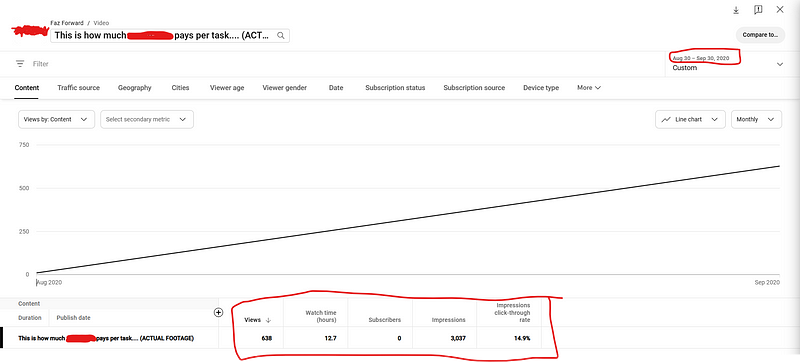
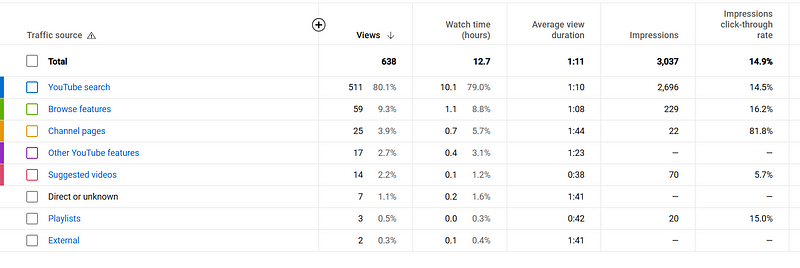
In the first 30 days, the video reached 638 views from 3,037 impressions. That’s a 14.9% average CTR. I was surprised to see it ranking 3rd in YouTube search results. That’s when I realized there was real potential, so I decided to make more videos.
My other videos
I decided to release two more videos about two other companies. It performed similarly: a steady increase of around 300 views per month.
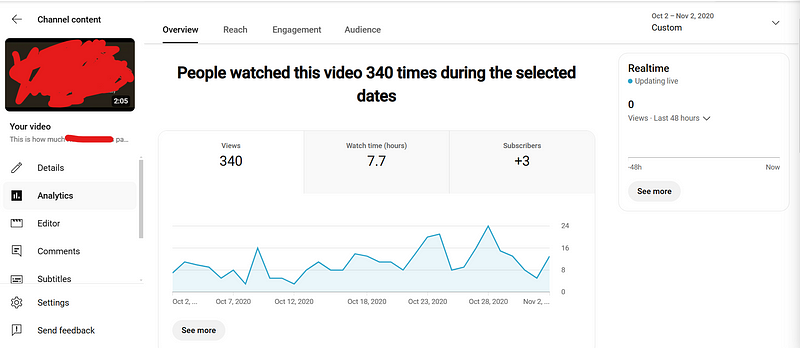
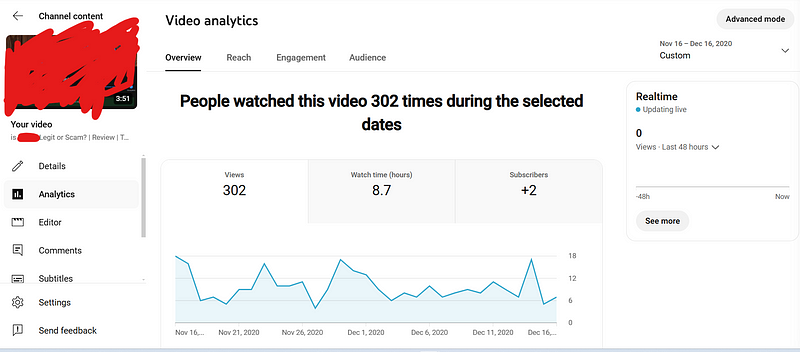
I was happy with the results. I was thinking about going more seriously. But then I got the job offer I’d always wanted. As someone who just started their career, I pursued a ‘real career’ instead of playing Russian Roulette by trying to become a full-time YouTuber. I figured I could always return to YouTube once I got used to my new job, and that’s precisely what I did.
After a while, I posted one more video, but it wasn’t another company review video. It was a computer tutorial. I was installing a file manager called OneCommander. When I tried to set it as my default file manager, I couldn’t find any tutorial online. So, I figured it out myself and posted a video so others wouldn’t have to.

Once uploaded, I forgot about it and continued with my life.
Abandoning the channel
After working for a while, I eventually lost my job. However, instead of returning to my YouTube channel, I found a business opportunity. It was cryptocurrency arbitrage. I learned I could make money by taking advantage of price differences between different crypto marketplaces. If you’re interested, I’ll cover it in another article.
Anyway, I ran that business for a while and made good money. Then I lost that business as well. Ideally, I’d apply for a new job or get back to YouTube immediately. But I was burnt out, got depressed, and began to develop an addiction. So, I was gone for a while, living off the money I earned from that business.
To Editor (please delete after review): I’m not sure if this ‘Abandoning the channel‘ section is necessary. I can’t tell whether the audience likes the relatability of it, or finds it long-winded. You can keep it, edit it, or omit it if you want. Please let me know why you decided on it, so that I can write better next time.
Revisiting the channel
After 4 years of working several jobs, running a business, depression, heartbreak, and battling addiction, I decided to take a look at my YouTube channel before getting into the job market again.
It had surprisingly good analytics.
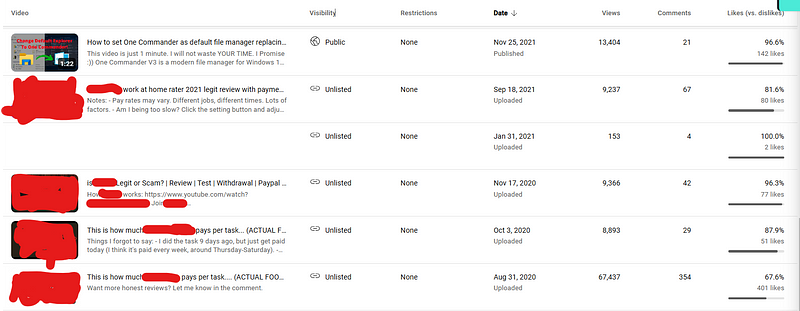
The channel reached over 100,000 views and had about 200 subscribers. So, instead of applying for a job, I decided to give it a go. It was too good to abandon. I could apply for a job later if it didn’t work out. Plus, I still have some money left to breathe and try something new.
Planning the new content (No more half-assed attempts!)
After my computer tutorial passed 10,000 views, I decided to turn it into a series. The idea generation process was very straightforward: I pulled every Windows app I used and ran keyword tests on TubeBuddy. If there’s a signal, I’ll make a video.
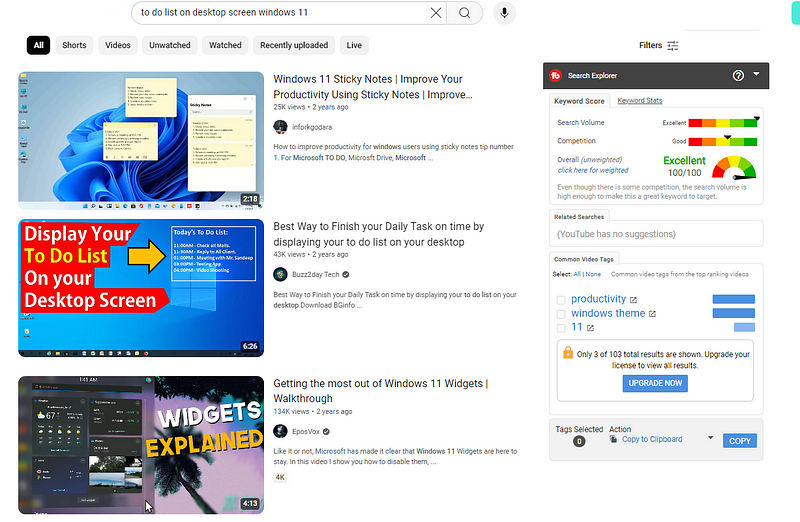
This resulted in 28 potential episodes I could make. Later, they’re all stored in my obsidian notes.
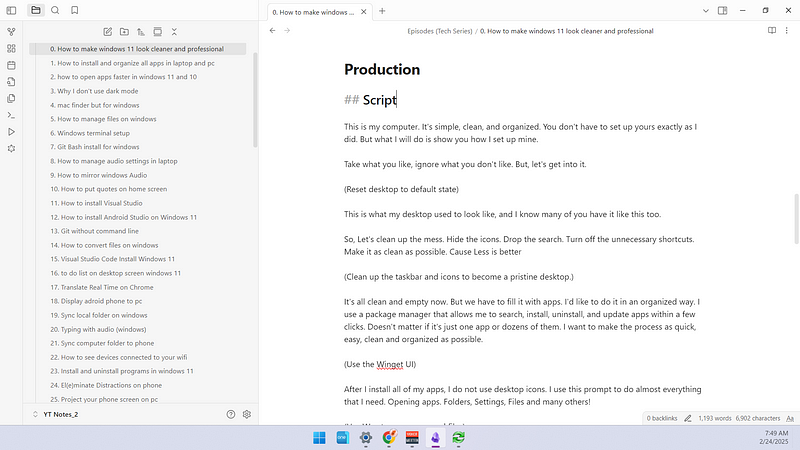
I organize them on an episode basis. Everything I needed was there: Title, Keywords, Description, Tags, Script, you name it.
Producing the new content
Then, I began to pre-record some videos. This serves 2 purposes:
- This proves that I have the discipline to produce one video a week.
- If something happens in my life, I would have more breathing room.
I ended up pre-recording around 8 episodes’ worth of footage. I was about to edit and upload it, but then…
Wrong Timing
It was June 2024. It meant summer vacation! Why should I start a tech-productivity channel on a summer vacation? People were busy going outside and enjoying life. So, I decided to postpone the release until September. So, I took all the time I needed. I trained my voice to sound better (I didn’t like my voice from my previous video). I worked on my storytelling. I made sure every single thing I did would look more professional.
I ended up scrapping 8 of my earlier videos after realizing I wasn’t happy with them, and recorded 3 new ones instead.
Releasing episode zero (tech)
The first thing I released was a channel trailer, a quick overview of how unique my Windows 11 setup is. My rationale was that I could be discovered by the “How to organize Windows 11” keyword when people search it.
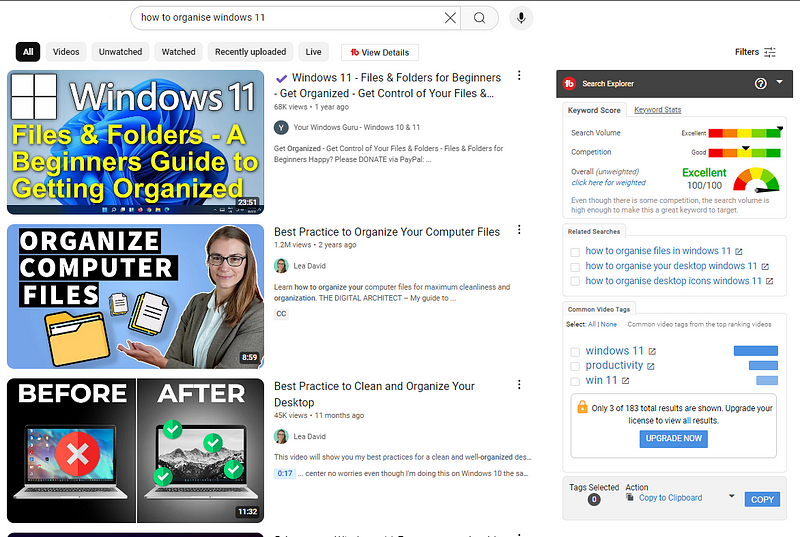
https://youtu.be/TjUC2d-SvUo?embedable=true
I uploaded it and got around 3,000 impressions in the first 4 hours, but only 44 views. 98% of them (impressions and views) came from recommendations. After 4 hours, YouTube stopped recommending it to people. A day later, I deleted it.
Then I reuploaded it with different thumbnails (changed the thumbnail every 1,000 impressions). I got around 4,000 impressions with only 40–50 views. The pattern was the same, so I deleted it again.
I uploaded it again with different thumbnails. This time it got 6,644 impressions but only 62 views.
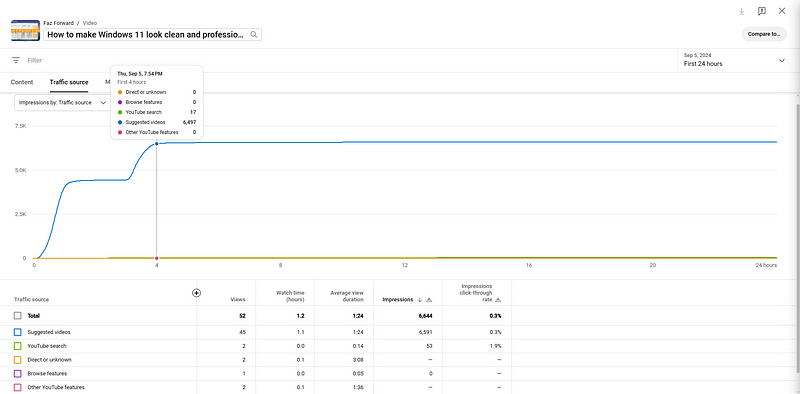
In retrospect, it seems obvious: nobody’s interested in the thumbnail and the title. Back then, I was in complete denial. I kept changing the thumbnail and the title. I even deleted and reuploaded the same video multiple times, and posted a question in the r/newtubers subreddit in the hope of shedding some light on this issue.
But it wasn’t improving. So, I just let it go and moved on to the next one.
Releasing episode 1 (tech)
Since the series focused on my Windows 11 setup, I started with a tutorial on installing, uninstalling, and updating apps efficiently using the Winget package manager.
https://youtu.be/yGFi0iEHjsU?embedable=true
I’ve got to say: the result was bad.
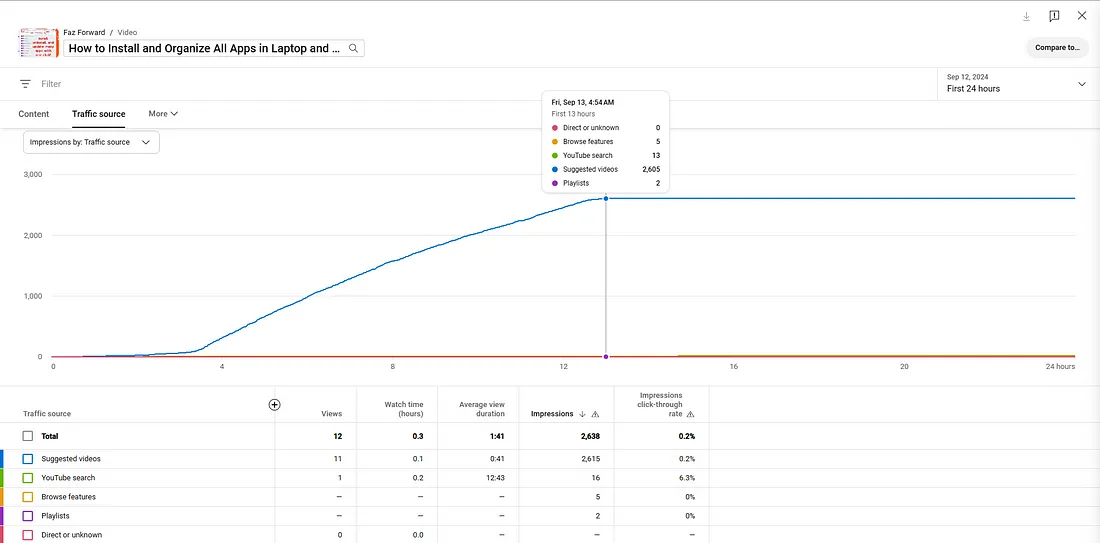
It was recommended to 2,600 people for 13 hours continuously, yet only 11 people clicked it. People who watched it didn’t stay long.
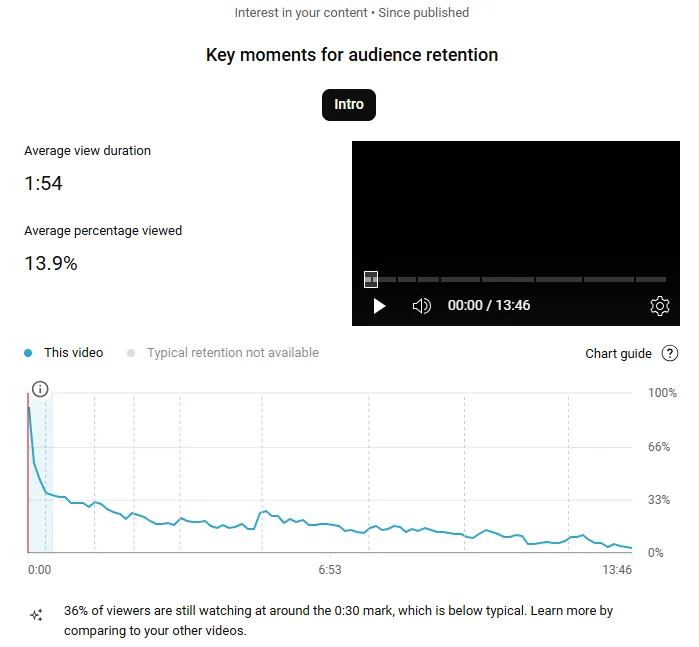
Reality check hit me: This isn’t working. So I decided to go for a walk. Then I have a new idea: Why not finish the rest of the 28 episodes while posting experimental stuff in between?
So, I gave it a try.
Trying something new
The first thing I tried was sharing a social trick I’ve been using, which is:
If you want to know someone’s values, ask what they hate.
I wrote the script and did some voiceover in Reaper. To make the message more effective, I decided to add illustrations throughout the video. I want to make it as quickly as possible. So, I slapped the audio to Canva and drew doodles throughout the video.
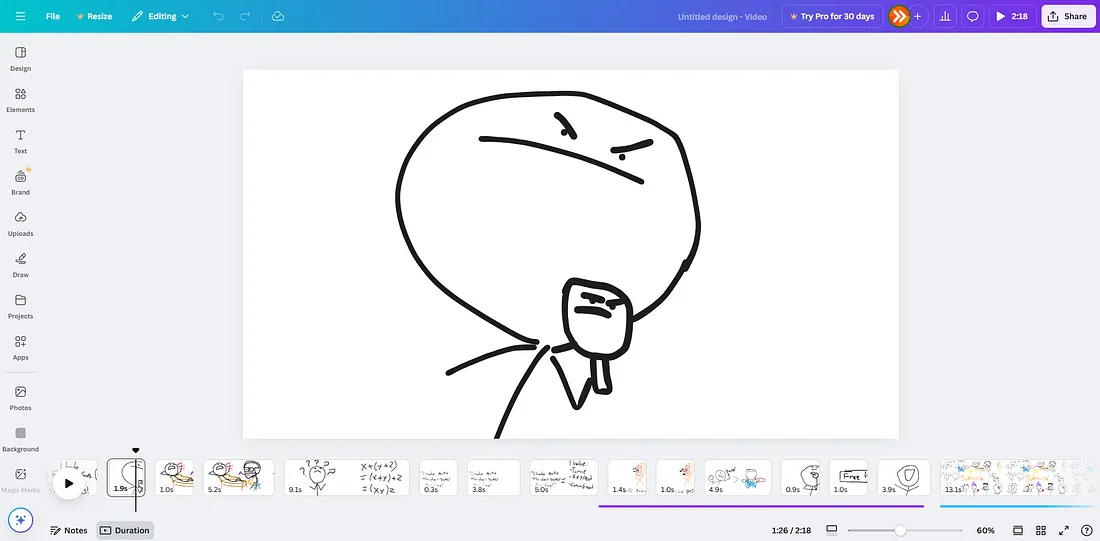
Here’s the result:
https://youtu.be/gI-_1ehetbo?embedable=true
Fingers crossed, I didn’t expect much.
Pleasant Surprise
At first, it performed just like my two previous videos: recommended to 2,190 people, and only 29 clicked.
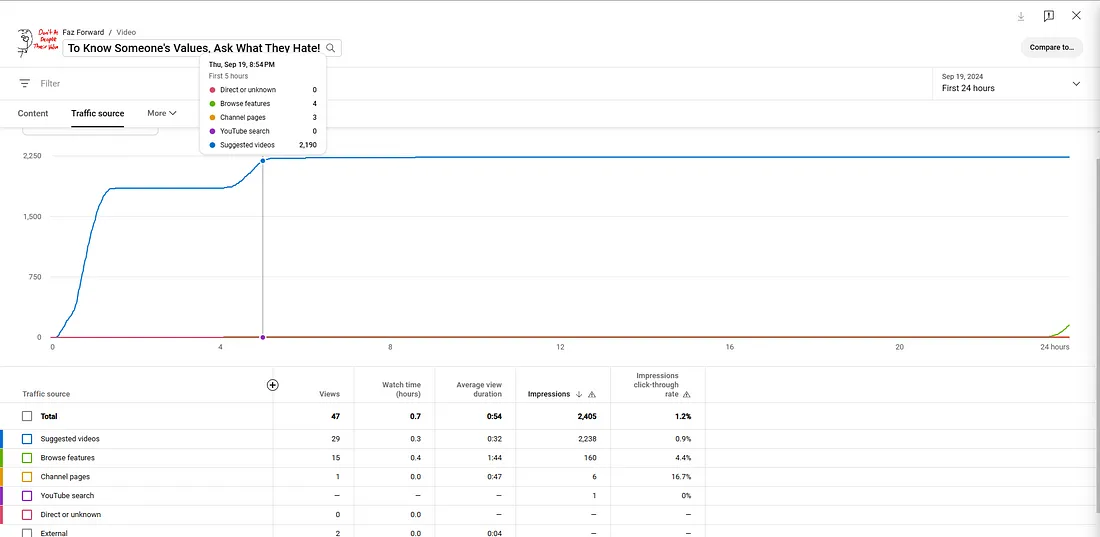
But then, something happened
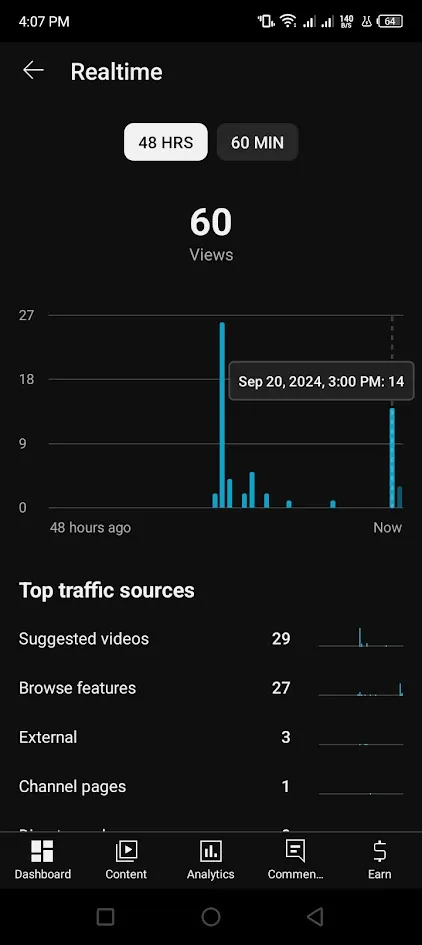
There was a sudden spike in views coming from browse features. Yes, my video went through the home feed, and people clicked on it. I was excited. Within three days, it appeared in 88,640 users’ feeds, generating 6,872 views!
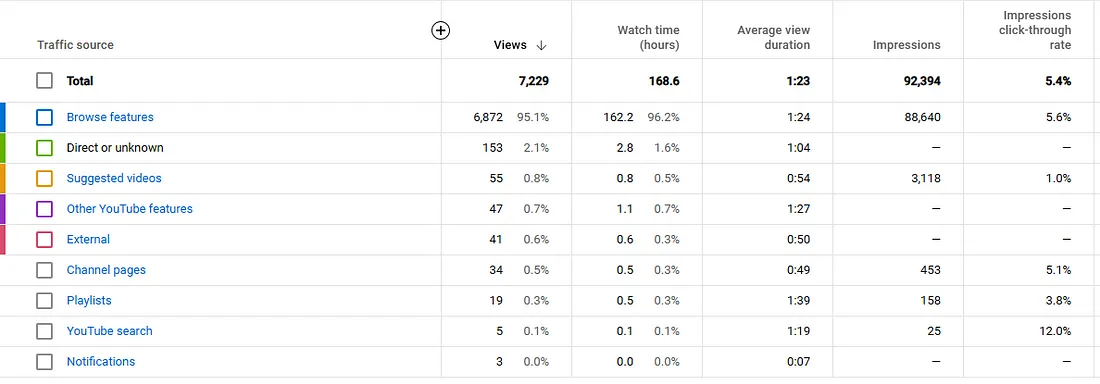
But then, all of a sudden, that excitement turned into anxiety.
Sudden Pressure
“This is it, a big break! I got to keep the momentum up,” I said to myself. Suddenly, there was this tremendous pressure to perform better. I felt like I shouldn’t waste this big opportunity. I couldn’t sleep. I kept overthinking.
“What if I mess this up?”
Then I decided to talk to some of my friends and get the load off my chest. I felt better. So, I started rock and rolling again.
Editor Note, please delete after review: Another section, which I’m not sure sounds too personal or not. Again, please decide whether to keep it or not, then tell me why.
A Stupid Mistake
It was 7 days after the first episode. The 2nd episode was only halfway done. In retrospect, I should’ve just finished it and released it a week later. But that didn’t happen. I thought releasing any video weekly would keep the algorithm happy. Better than not uploading at all. So that’s what I did.

I released one announcement video and another pre-recorded tech video to cover the next two weeks.
(Yet another) stupid mistake
I already pre-recorded the next 2 Doodle episodes, ready to upload. In hindsight, I should’ve stuck to my usual schedule. But for some reason, I was using TubeBuddy’s “best time to upload” feature instead for the second upload.
It performed badly.
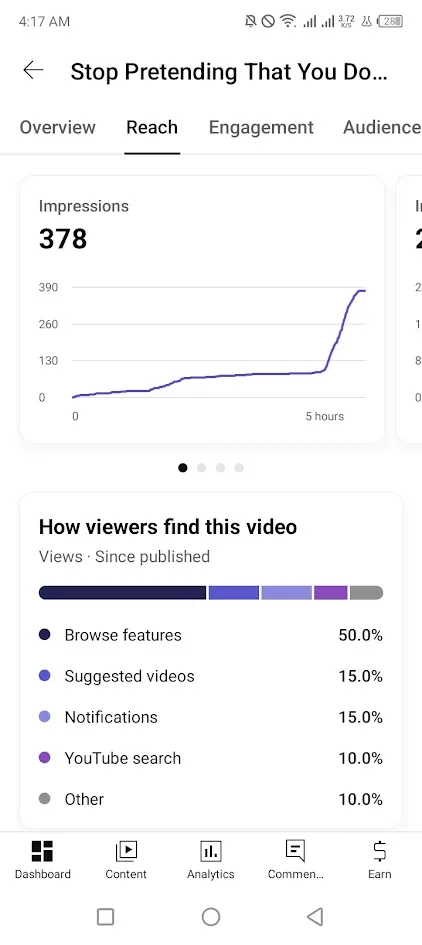
Remember how I got thousands of impressions within the first 4 hours, only to have nobody click my videos?
Now, I have the exact opposite problem: It’s the video people like, but YouTube only gave me 378 impressions, as opposed to the usual 3,000–6,000 impressions.
So I deleted the video and made another announcement video.
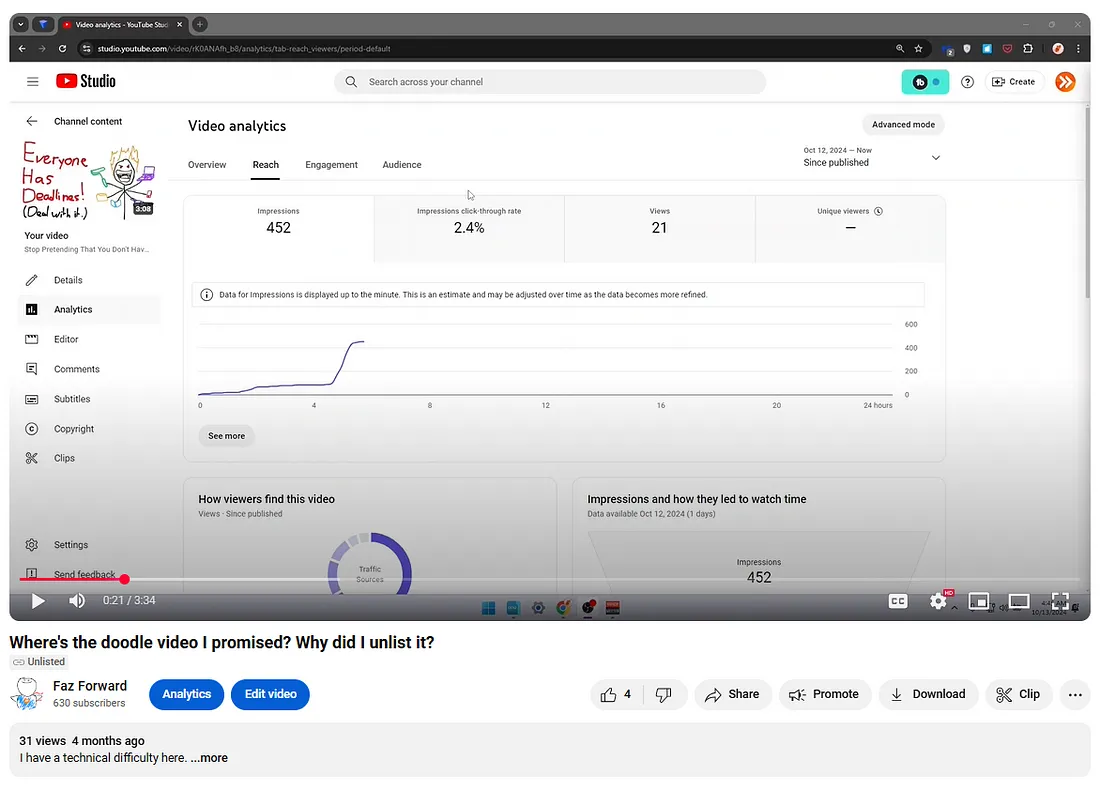
Then, I re-released the second episode the very next week at my usual schedule.
Releasing the second doodle video
The impression was improving, but not as good as I expected.
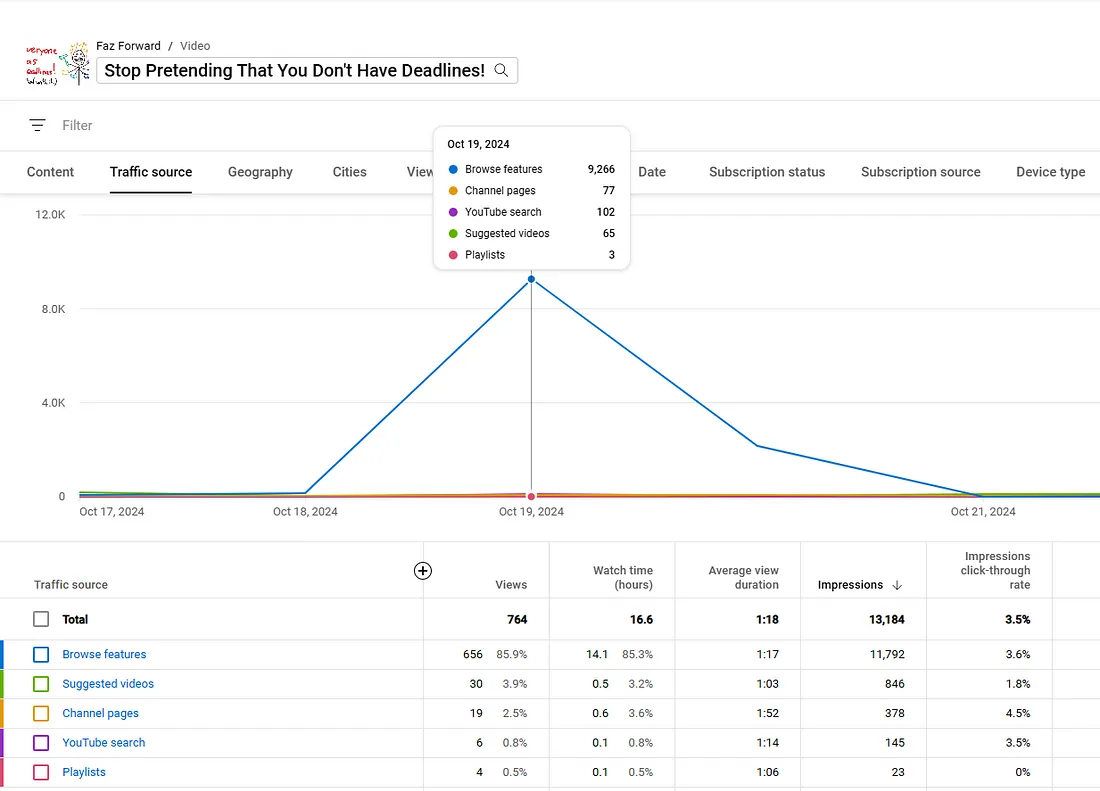
The pattern was back: The first 24 hours, it was being recommended in the “Suggested videos” section, with only a few people clicking. Then a wave of “Browse features” came in and started lifting the view counts up to 764 views within the next few days.
But it wasn’t going to last long.
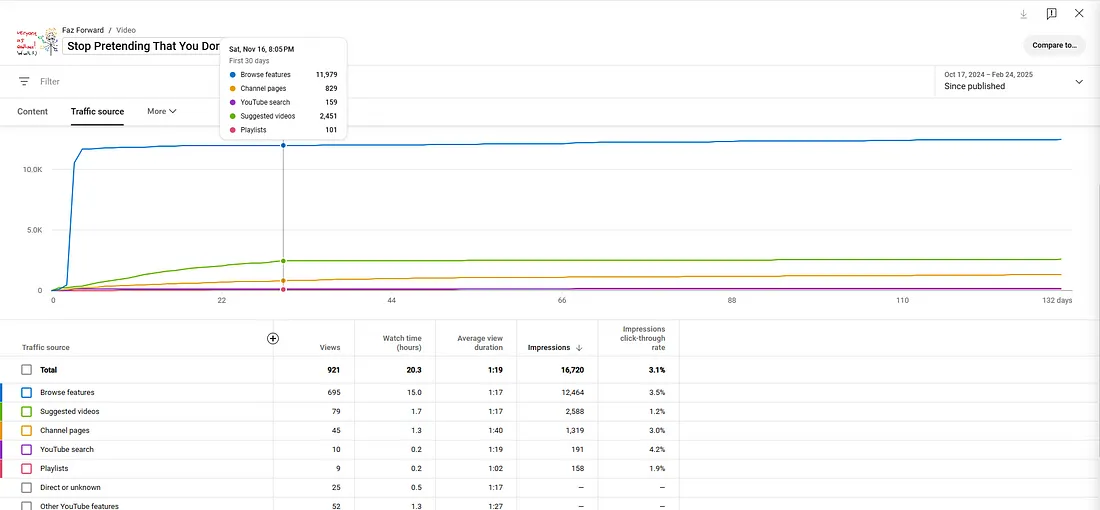
The “browse features” traffic peaked after 4 days. The “suggested videos” traffic continued to rise slowly until it flattened out at some point.
At this point, the first doodle episode has amassed around 20–30k views. But then, the second episode’s performance was disheartening. Thankfully, I have anticipated this morale issue by pre-recording 2 episodes ahead.
I released two more episodes for the next two weeks while also investigating what happened.
Going back to irrelevancy
2 more episodes have been released. Both were flopped, and I haven’t found the culprit.

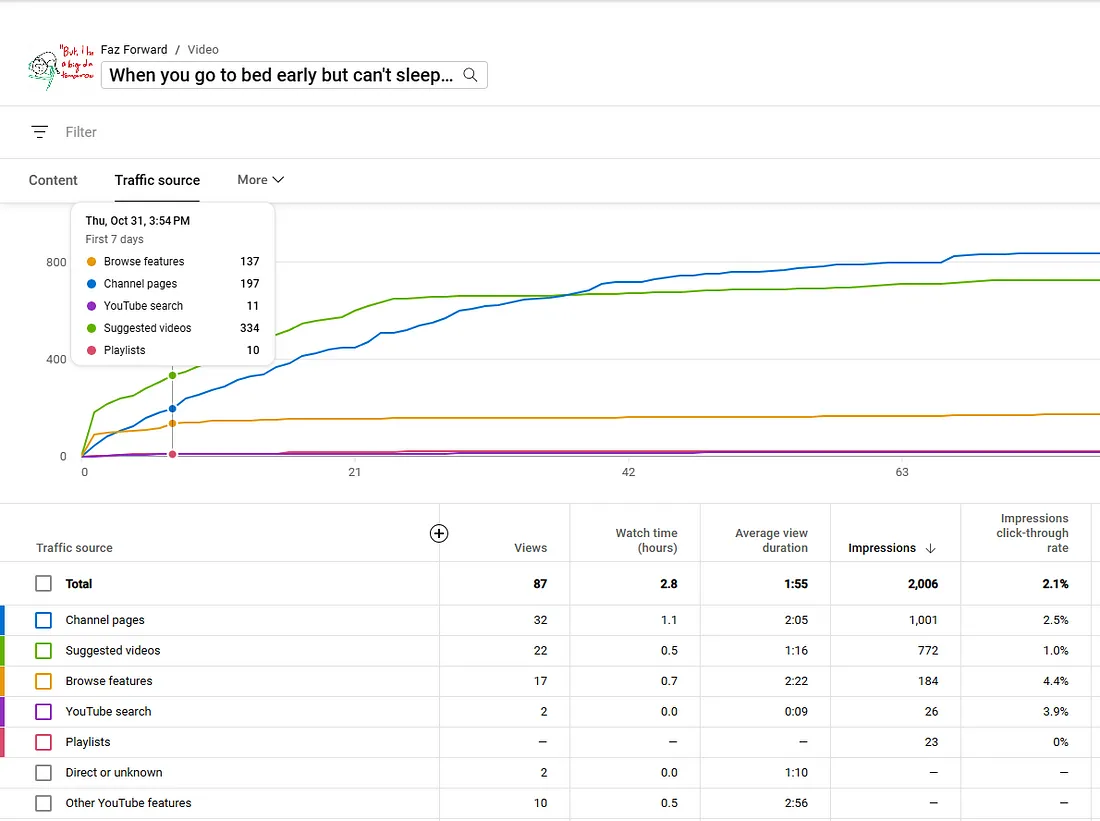
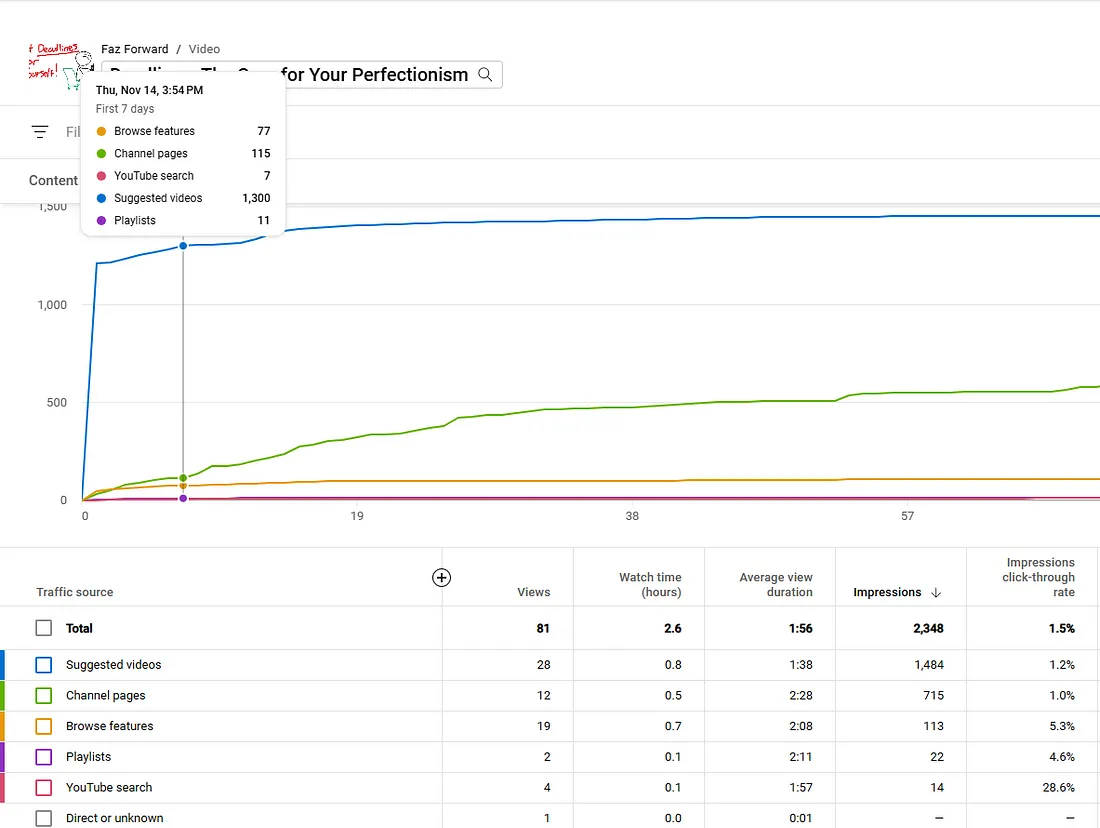
As you can see, YouTube was no longer providing adequate browse traffic. You might say, “It was because the audience was no longer interested!”. But so far, the retention rate is decent.
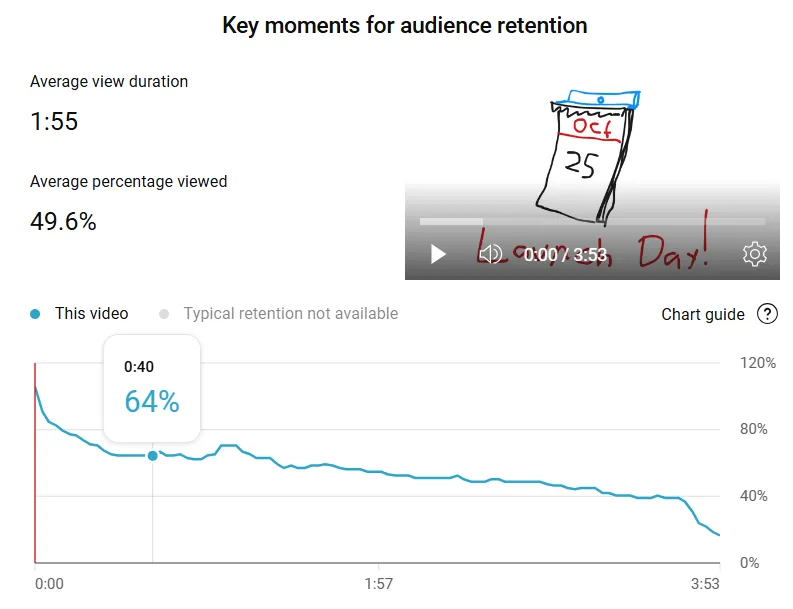
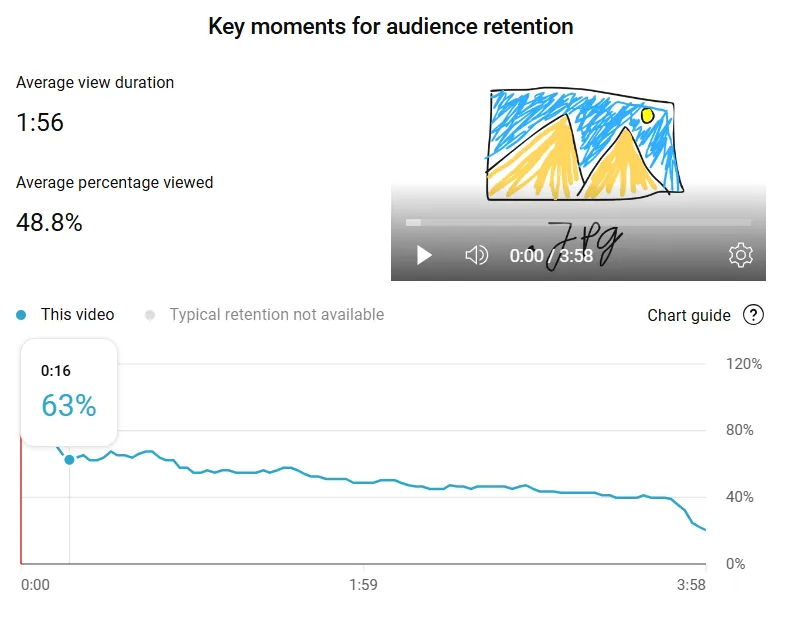
Is it Shadowban?
Not long after, I found this video:
https://youtu.be/H6d__-xSjok?embedable=true
Then I checked my channel to see if my videos had also been restricted. Yep, all of my new episodes except the first doodle episode got restricted.
https://youtu.be/88J15kLVdUc?embedable=true
Even when I uploaded the video documenting how my other videos were being restricted, it was also being restricted!
Appealing to YouTube
After I found out, the first thing I did was to submit a couple of forms:
The first one was the “Send feedback” form on YouTube Studio.
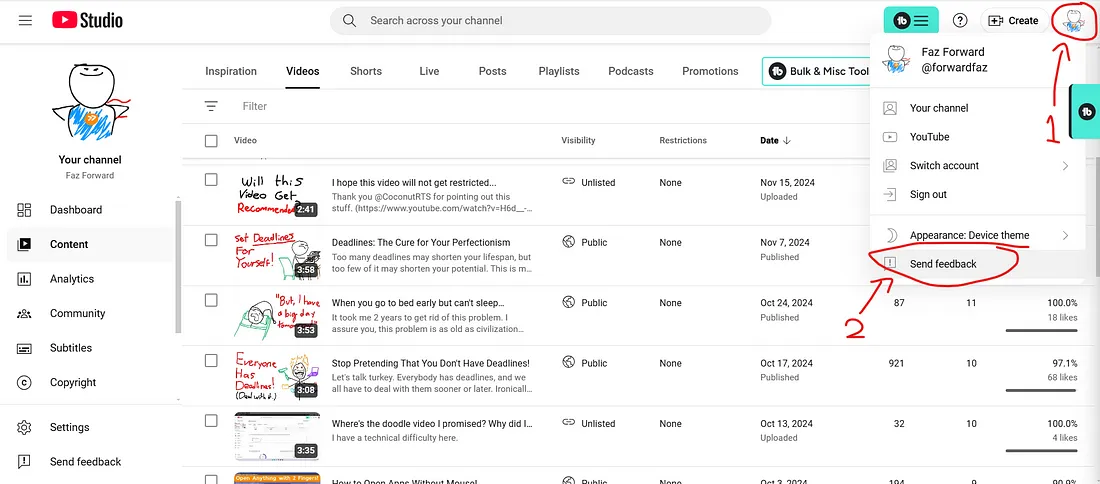
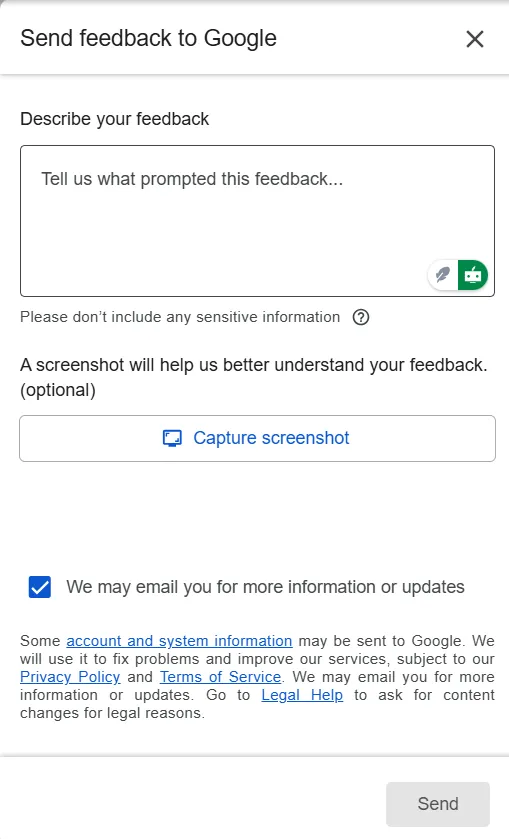
The second one was the YouTube Help Restricted Mode Appeal page.
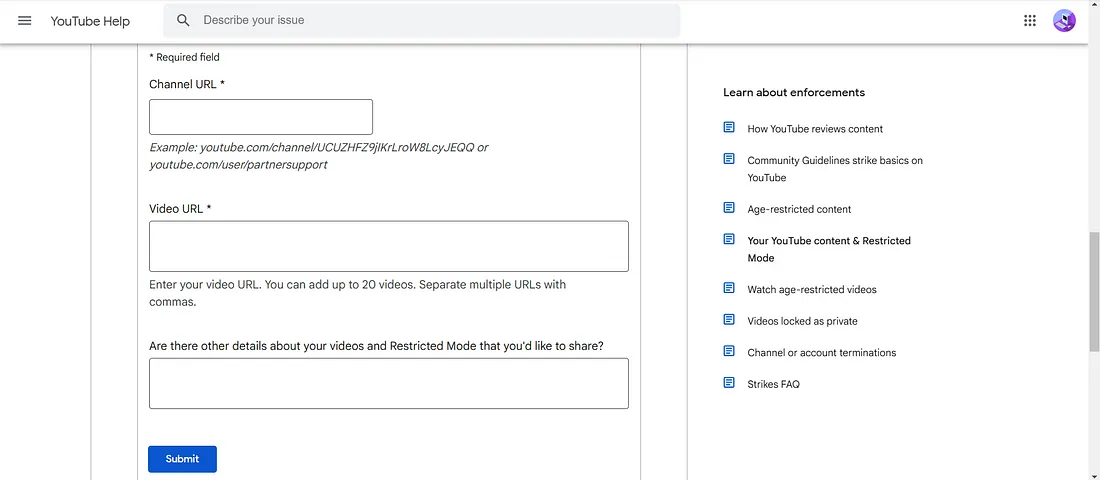
I don’t know which one helped, but after 24 hours, my videos were unrestricted. Did it get impressions again? Sadly, no. But it gave me hope to start uploading again.
Restriction Lifted (or was it?)
I uploaded another video, titled “What to do when your friend rants“:
https://youtu.be/-PF4O8pSfns?embedable=true
Guess what?
It instantly got restricted by default. I was frustrated. So I went through the YouTube Help Restricted Mode Appeal page. 3 days later, no answer.
Then, I went through the “Send feedback” form on YouTube Studio. Yet another 3 days, no answer.
So, I was contacting @TeamYoutube on Twitter. I even made a video explaining the issues.
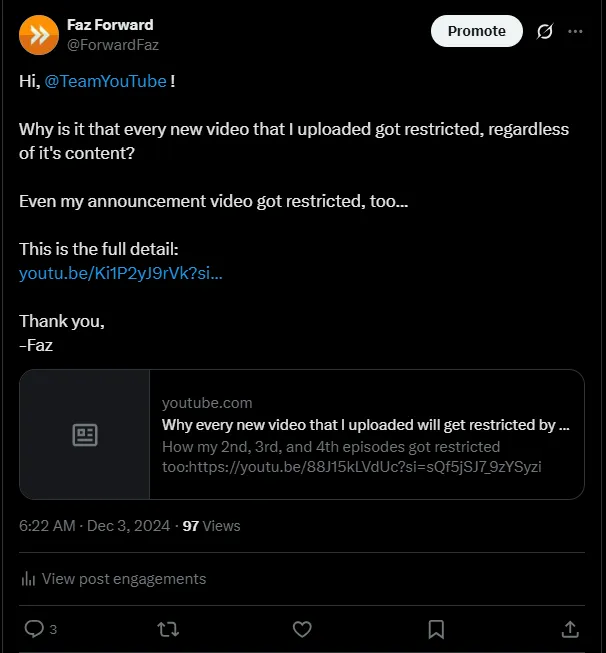
https://youtu.be/Ki1P2yJ9rVk?embedable=true
Hours later, I got some automated replies.
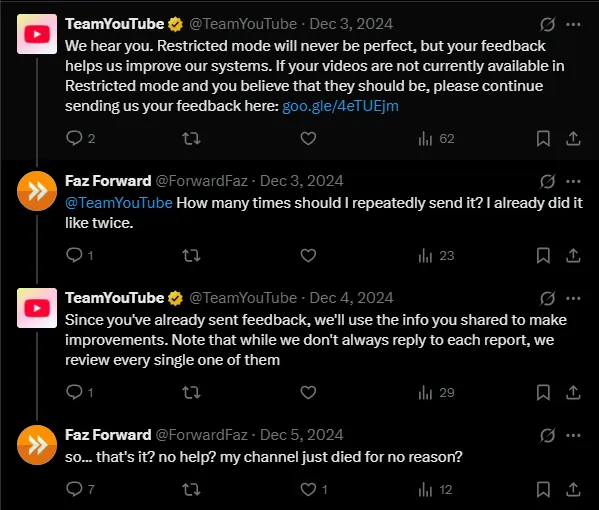
They didn’t even check the video I’ve sent. The view count was still zero when I got the replies. Then I just gave up for a while, until…
A Hail Mary attempt
I was frustrated and told people how every video got restricted for no reason.
https://youtu.be/Se0ViyOPvok?embedable=true
Ironically, this one wasn’t restricted. So, I decided to make another video.
https://youtu.be/6mLDOzTyNw8?embedable=true
It wasn’t restricted and got 6,338 impressions within 31 days. But mostly from suggested videos, not browse features.
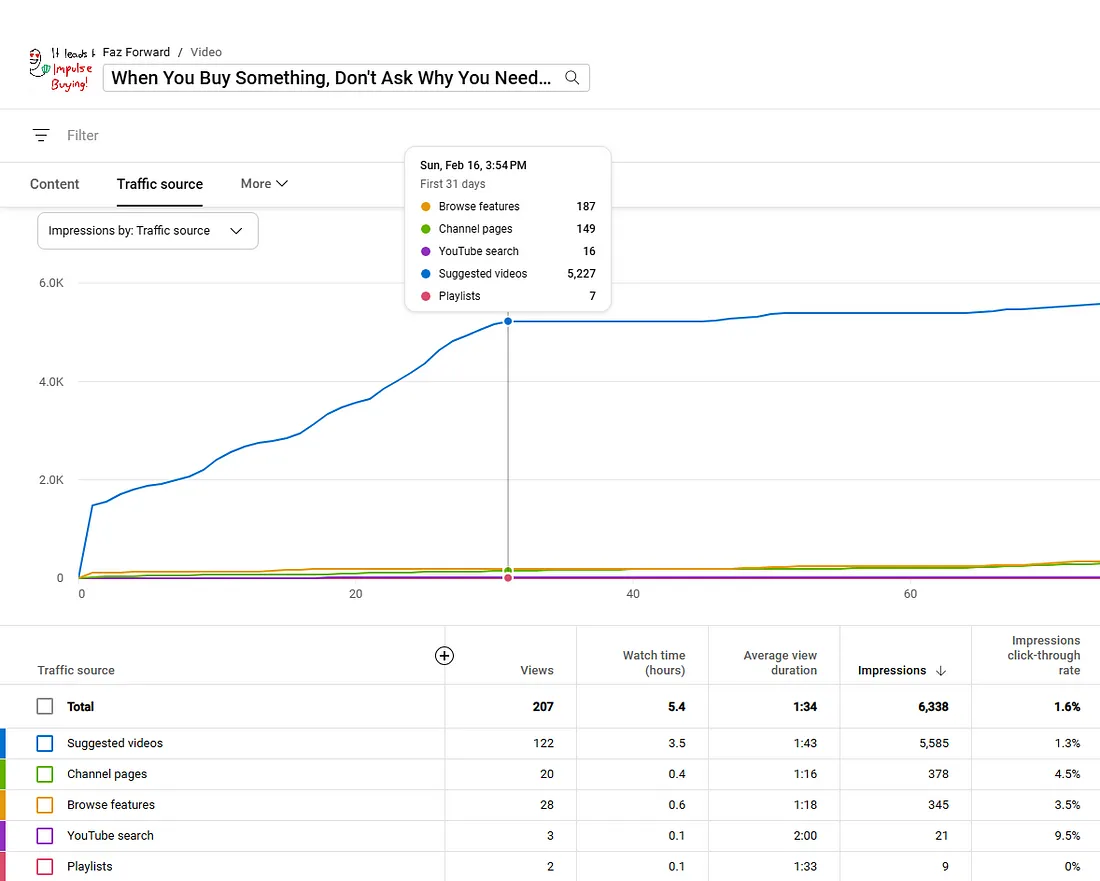
Is this the end? I began to think of a few possibilities:
- I’m no longer relevant.
- My newer video isn’t that good.
- The momentum is gone.
- I got lucky the first time.
- A lot of wrong steps, like deleting videos, posting filler stuff, etc.
But one way to find out:
Uploading to a secondary channel
I created a brand new channel and posted a video. It got the browse traffic I wanted, but the performance isn’t good.
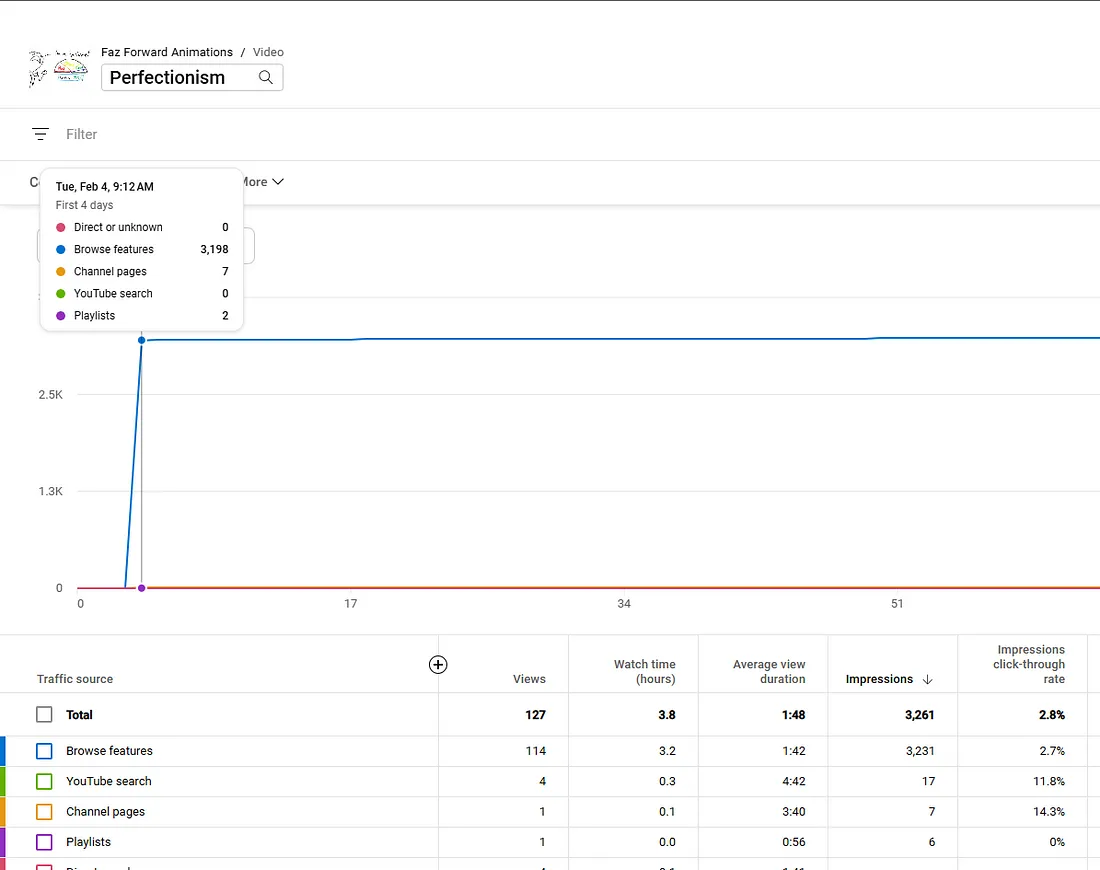
When I put it on the main channel, the performance was worse.
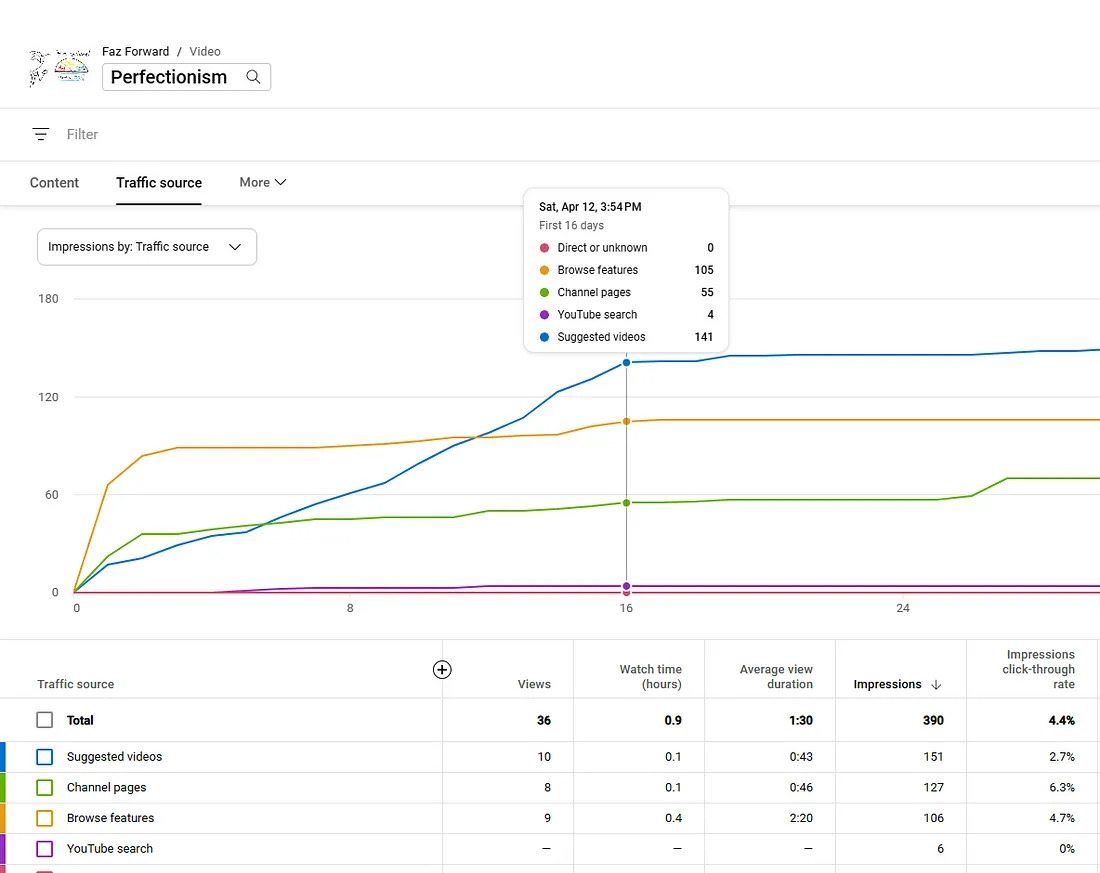
Calling it quits
I realized the problem could be my video, and that YouTube is more random and complicated than I thought. Does that mean it’s not worth it? Not really, but at this point, I probably have better results in working a real job again or starting a business.
I hope you can learn a thing or two from my mistakes.
What I’ve Learned
1. Don’t overplan 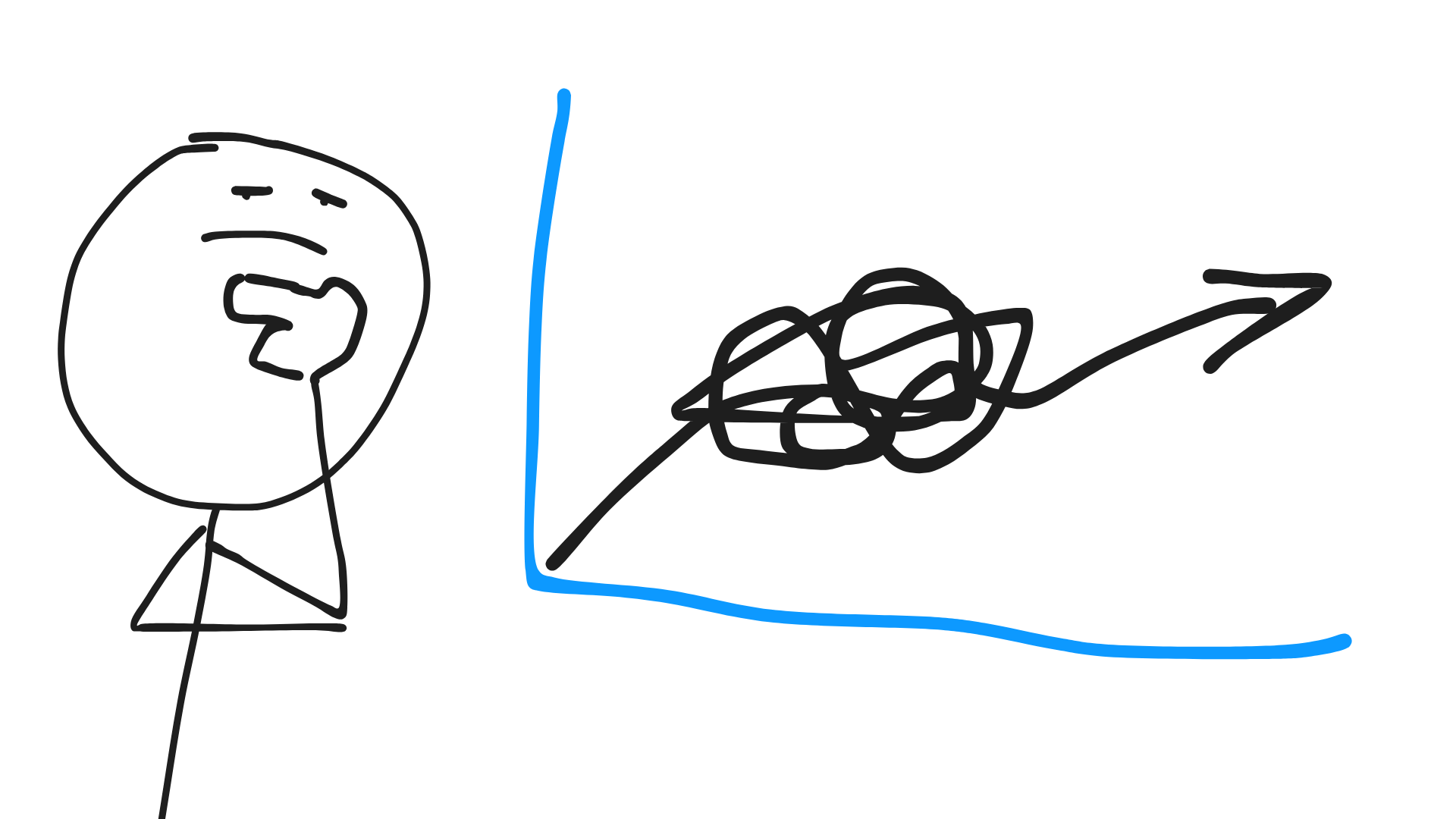
Spending a lot of time planning and perfecting a video doesn’t necessarily guarantee that it will take off. We could read a lot, watch a lot of tips on YouTube, ask around on Reddit, and put a lot of hours into production. Only to find out that the video didn’t take off. There’s nothing wrong with putting in a lot of work, being prepared, and doing a lot of research. But it will kill your morale quickly when the feedback isn’t what you’d expect.
Planning takes effort. But with that same effort, you could’ve released several videos. A strategy that’s less likely to kill your morale. It’s easier to move on and learn when you haven’t spent 30 hours on a single video. Plus, you get better ideas from real-world feedback. I’m telling you, simply releasing a few bad videos, trying out what works and what doesn’t, and learn from your own mistakes will give 10x more information than pondering about executing a perfect launch.
In short, Planning is good. But, when the effort exceeds making actual videos, it quickly gets demoralizing and counterproductive.
A good question to ask yourself is: “How many videos could I’ve released by now, instead of doing all this ‘research’ or ‘perfecting my video’?”
2. Use common sense before resorting to software/quantitative data
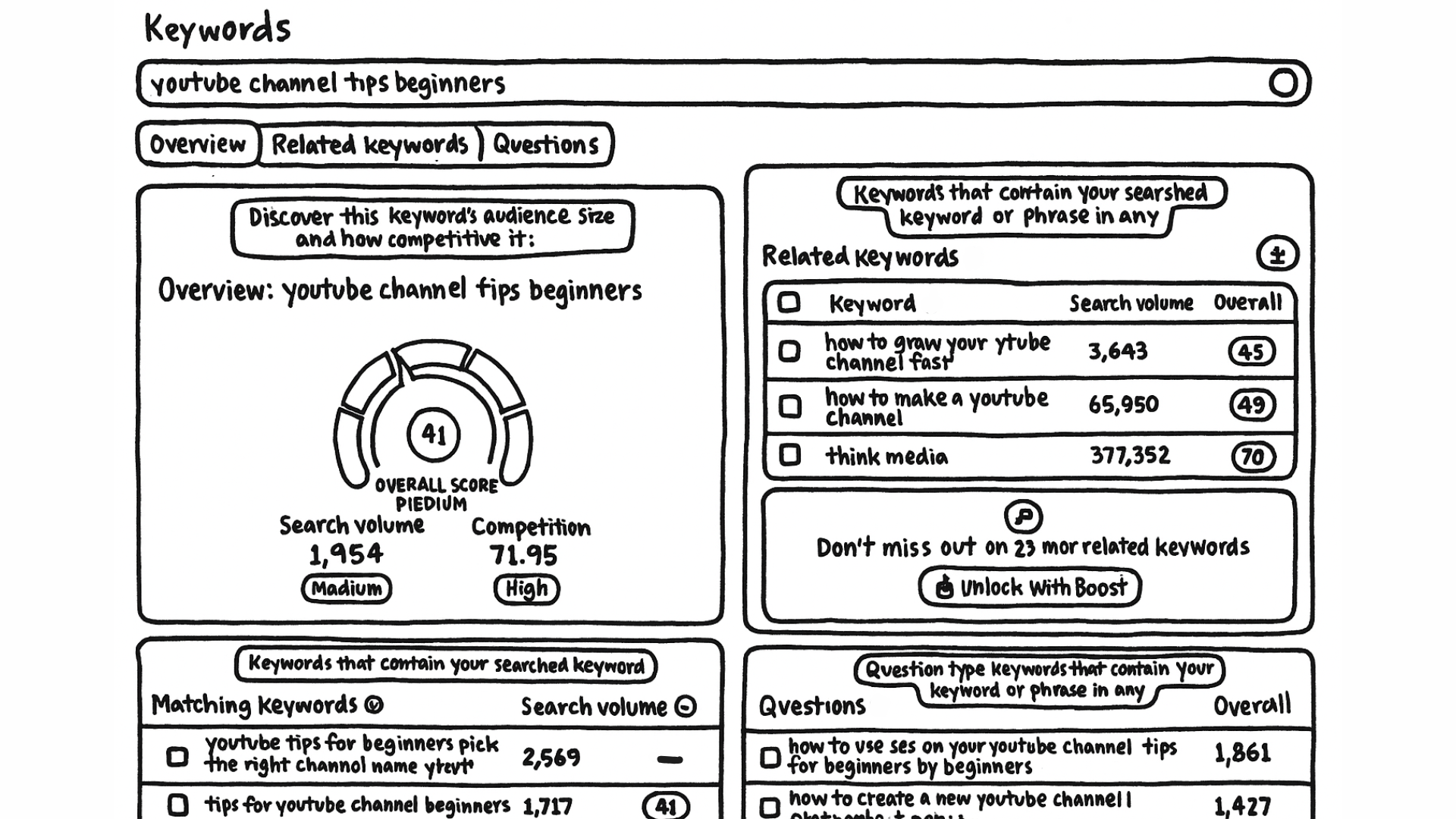
My video usually fails to gain traction (low CTR & watch time) when I use keyword scoring software without passing a common-sense test first. Don’t get me wrong, they’re great. But using them without context won’t fix an uninteresting video.
It’s easy to fall into the trap of gaming the keywords and spamming unrelated terms into the metadata because we thought that would increase our reach. Yes, it may increase the reach. Only to the wrong audience who aren’t interested. Resulting in poor performance. We often forget that, ultimately, actual individuals are watching the video.
A good practice would be to use common sense first, then use the software/data to filter out your ideas. These are a couple of concrete examples:
- If a program greenlights you to make a video about a topic, be honest before doing it: Act like the audience and search for the video you need. Has somebody already made a still-relevant video with decent quality? Does that one already satisfy your needs? Could you make one that is better or different from that one? If the answers aren’t satisfactory, move on. This is what I meant by ‘common sense test‘. The software/data approach usually only works if it has been put to the test. If it passes, then you can use the app to filter out which one of your ideas has the strongest keyword score.
- Prioritize real-world feedback. Unless you’re a pro who has successfully released hundreds of videos, started a bunch of channels, or has an excellent reputation, the more effective way to learn is to release videos first, then gather the metrics and see what happens. That’s usually more useful, effective, reliable, and less confusing than overanalyzing dozens of metrics before releasing videos. Besides, it usually takes less effort and time to plan less and do more. Perfect if you have nothing to lose.
3. Early Start > Perfect Launch.
 On average, there are over 20 million videos uploaded daily to YouTube. The later you start, the harder it is to compete. I made the mistake of overly obsessing over a perfect launch by taking months to perfect it. I pre-recorded 8 episodes only to throw them away later. In hindsight, I shouldn’t have done that. All of my subpar videos with ‘lower production value‘ actually performed better, partly because they were released years earlier.
On average, there are over 20 million videos uploaded daily to YouTube. The later you start, the harder it is to compete. I made the mistake of overly obsessing over a perfect launch by taking months to perfect it. I pre-recorded 8 episodes only to throw them away later. In hindsight, I shouldn’t have done that. All of my subpar videos with ‘lower production value‘ actually performed better, partly because they were released years earlier.
Good enough videos usually perform better if released early, compared to better ones released later.
4. Never Delete Videos!
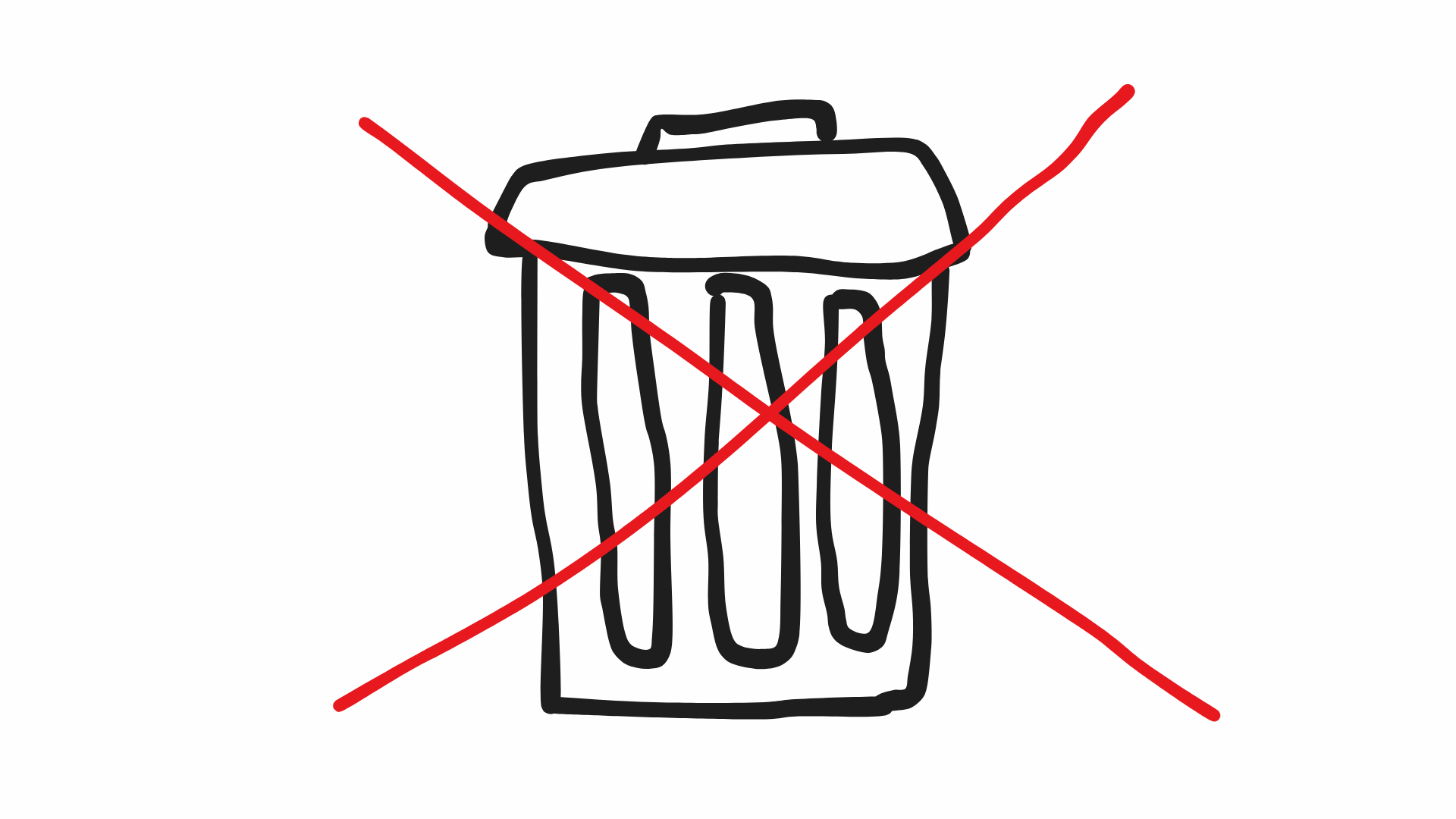
YouTube ranks channels based on the metrics of their videos, including older videos. Even if you think your old videos suck, chances are, they will still help your channel rating. On the contrary, deleting videos often means reducing your channel rating! If you have to delete, however (maybe due to a controversy or information you accidentally leaked)… You could simply private/unlist the videos.
5. Never release filler videos

When I hadn’t finished the main video, I thought I could slap a random video, such as an announcement video, to keep up with the schedule. I couldn’t be more wrong. It killed the momentum: I went from being recommended to 3,000-6,000 people within 24 hours to less than 500.
I would be better off not releasing anything, and ONLY releasing similar videos to the one that has the most views, even if it took longer.
Consistently releasing IRRELEVANT videos < inconsistently releasing RELEVANT videos.
6. Double down on what works
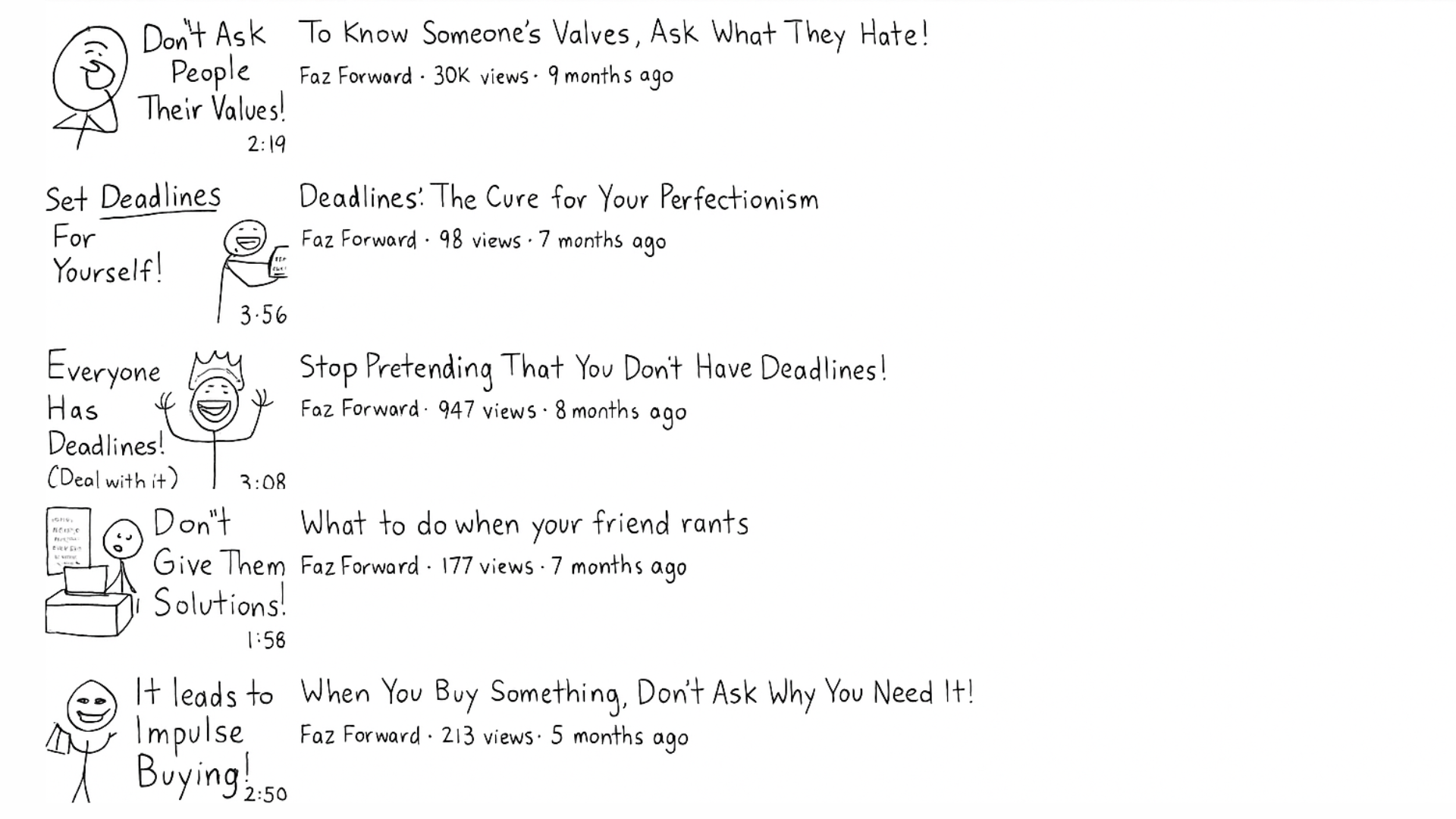
I changed formats when my channel had nothing to lose. It works, and I gained momentum. However, I was too greedy and kept experimenting even when things were going well. I still released other formats, and even changed the upload schedule, but it killed the momentum. In hindsight, once I got something that worked. I should’ve doubled down on it. Only releasing similar videos with a consistent format and the same schedule.
Whether it’s video style, titles, description, or even upload schedule, stick to what works. If something worked and gained momentum, experimenting with something new can be risky.
7. If a video format doesn’t work, try something new
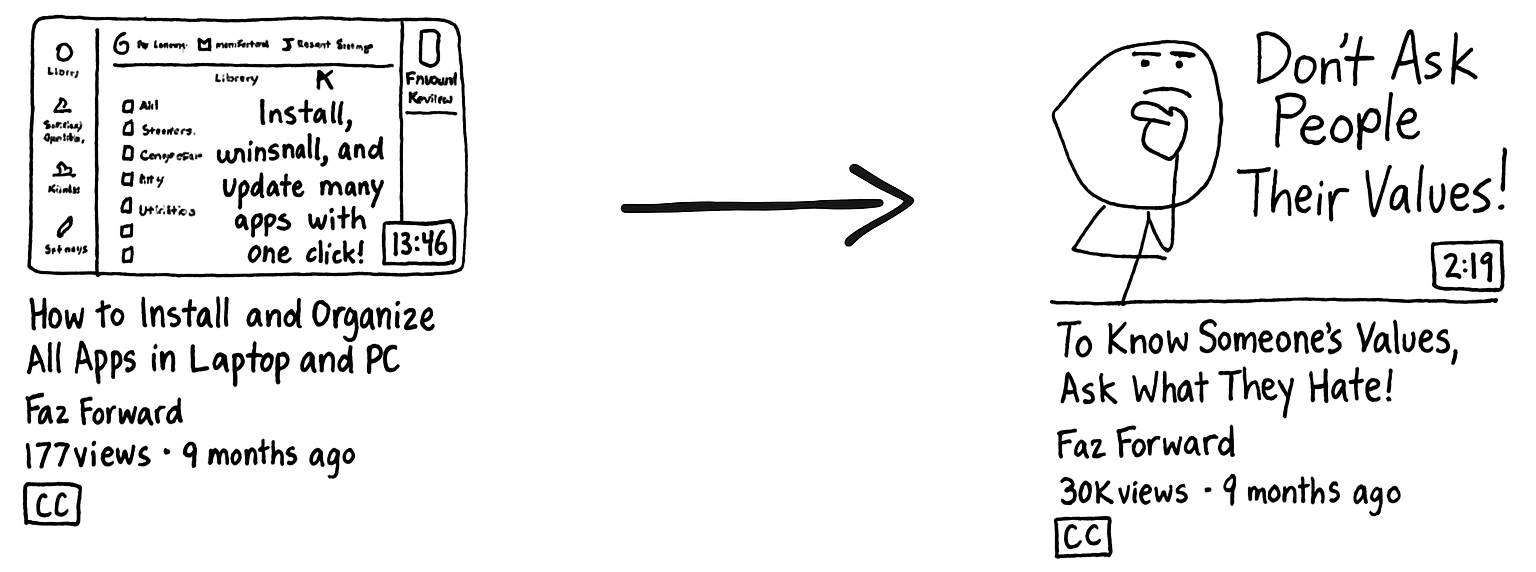
Many people have blind optimism of “keep releasing new videos” regardless of the feedback. Don’t get me wrong, consistently releasing videos is a good practice. But that doesn’t mean releasing identical formats. If you already have proof that it doesn’t work, like low CTR or AVD, you’ve got to experiment. Yes, you can keep releasing the same videos, especially if you enjoy doing it. But it doesn’t hurt to keep inserting experimental videos from time to time. The safest bet would be releasing an experimental video in every other regular video.
8. Every video should appeal to new users
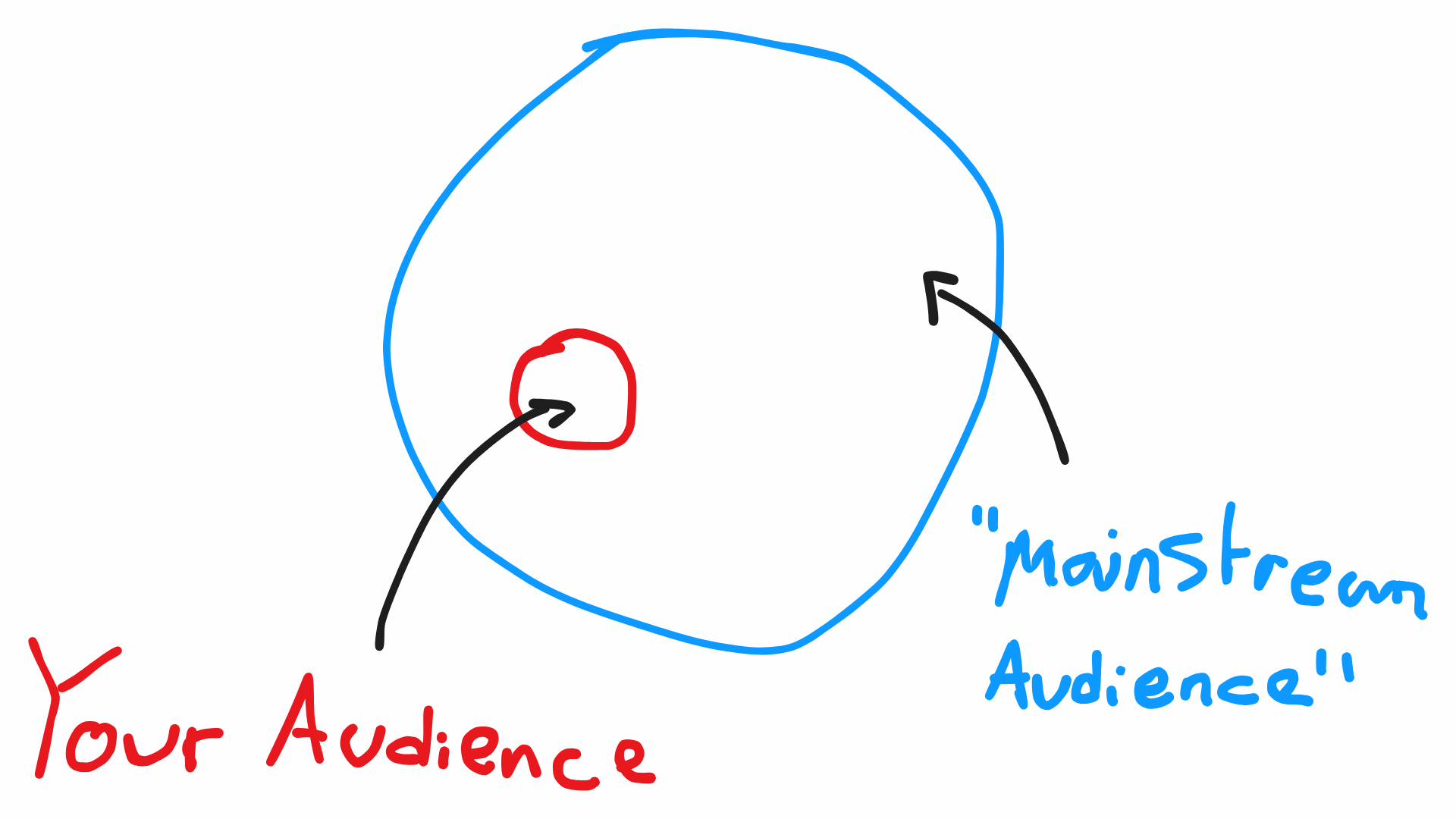
It’s easy to believe that just because a video got a lot of views and good feedback, we think that people like us, as creators, not because the video delivers value. Sure, some creators have the natural talent to become a personality; the audience will watch them because the creator is inherently entertaining, charismatic, or carries a lot of authority. They will watch any video they release. But that isn’t the case for a lot of people, including myself. When I made a video, people mostly cared about the value it delivered at that time. Once I make something they don’t care about, they quickly forget that I exist.
That’s why I try to strip away any inflated idea of how interesting I am as a person, and instead focus on making sure every video delivers value without strings attached.
9. YouTube is random and arbitrary

Nobody knows about the algorithm and the rules. It keeps changing, and when it changes, it may seem random and arbitrary. A lot of channels with millions of subscribers are suddenly losing 90% of their views. Channels that didn’t do anything sometimes get terminated or shadowbanned without a valid reason. While some channels that blatantly promote scams, gambling, and explicit content get a pass.
As a user, sometimes YouTube stops recommending or even notifying us about videos from creators we’ve subscribed to. More often than not, YouTube does the exact opposite of what users want.
YouTube restricted three of my videos, and my channel’s recommendations decreased by 95%.
Why is this important? Because sometimes, we get fixated on one platform; we become a “YouTuber” instead of a “Creator“, for instance. YouTube’s arbitrary and often unfair behavior reminds us to think bigger: diversify our presence, explore new formats, secure brand deals, grow outside the platform, and build direct relationships with our audience. You’re not just a YouTuber. Ultimately, you’re a Creator, and you can, and SHOULD create anywhere.
10. YouTube isn’t all about creating content. A lot of it is just dealing with BS
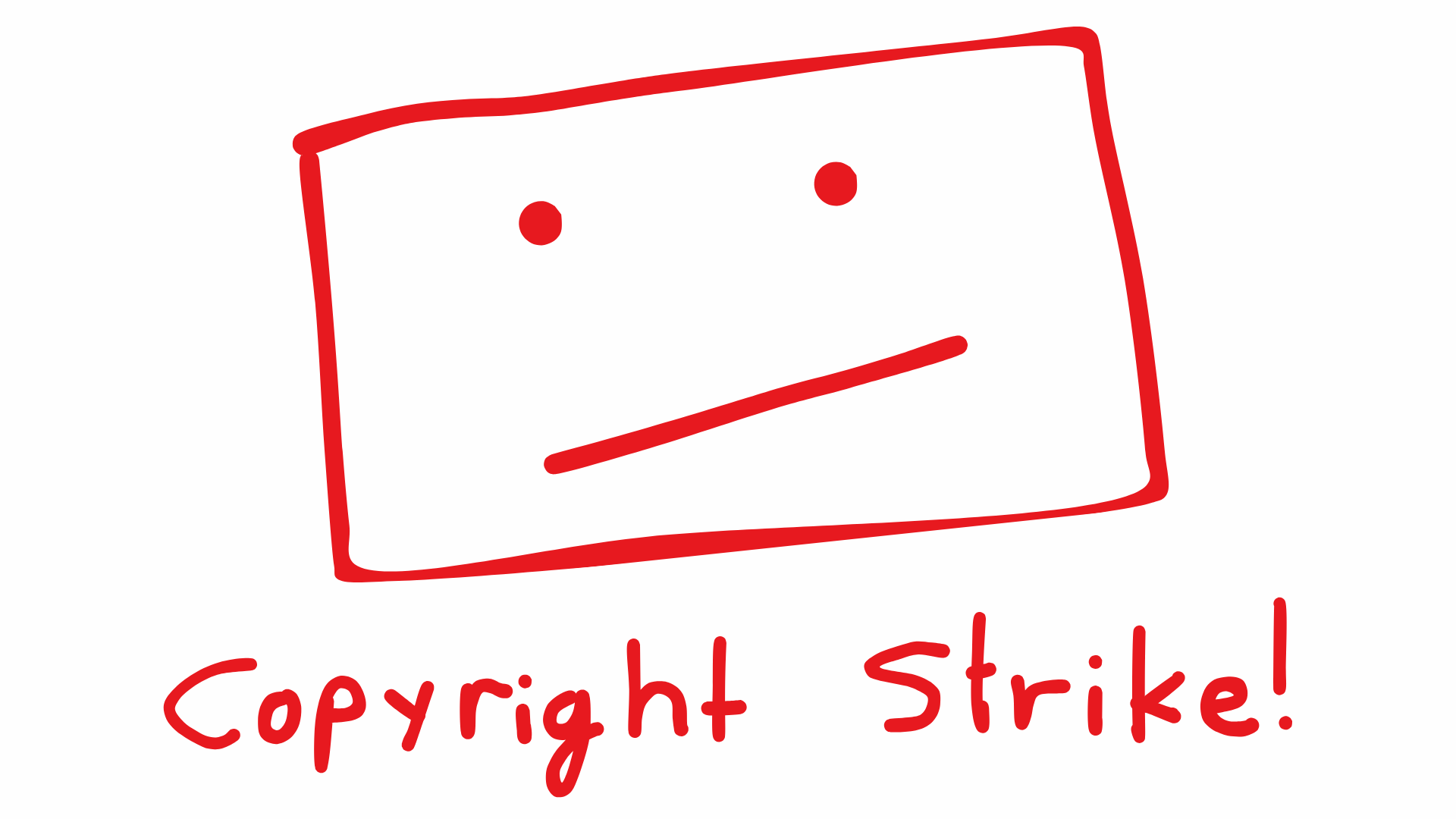
As mentioned in the previous point, YouTube can be so random and arbitrary. If you believe in Murphy’s laws, it will happen to you eventually. People will steal content. You’ll have to deal with copyright issues. You’ll get your videos wrongly restricted, removed, or shadowbanned. You’ll have to deal with almost nonexistent YouTube support that gives a copy-paste answer. The list is endless.
Like anything else, it’s work. It has lots of parts you don’t like, but you have to deal with them anyway. Sure, you can create for fun; try it as a hobby or treat it as a creative outlet. But if you want to make a career out of it, please be honest about the workload and compare it to other opportunities in your life.
11. Gaming the algorithm is risky
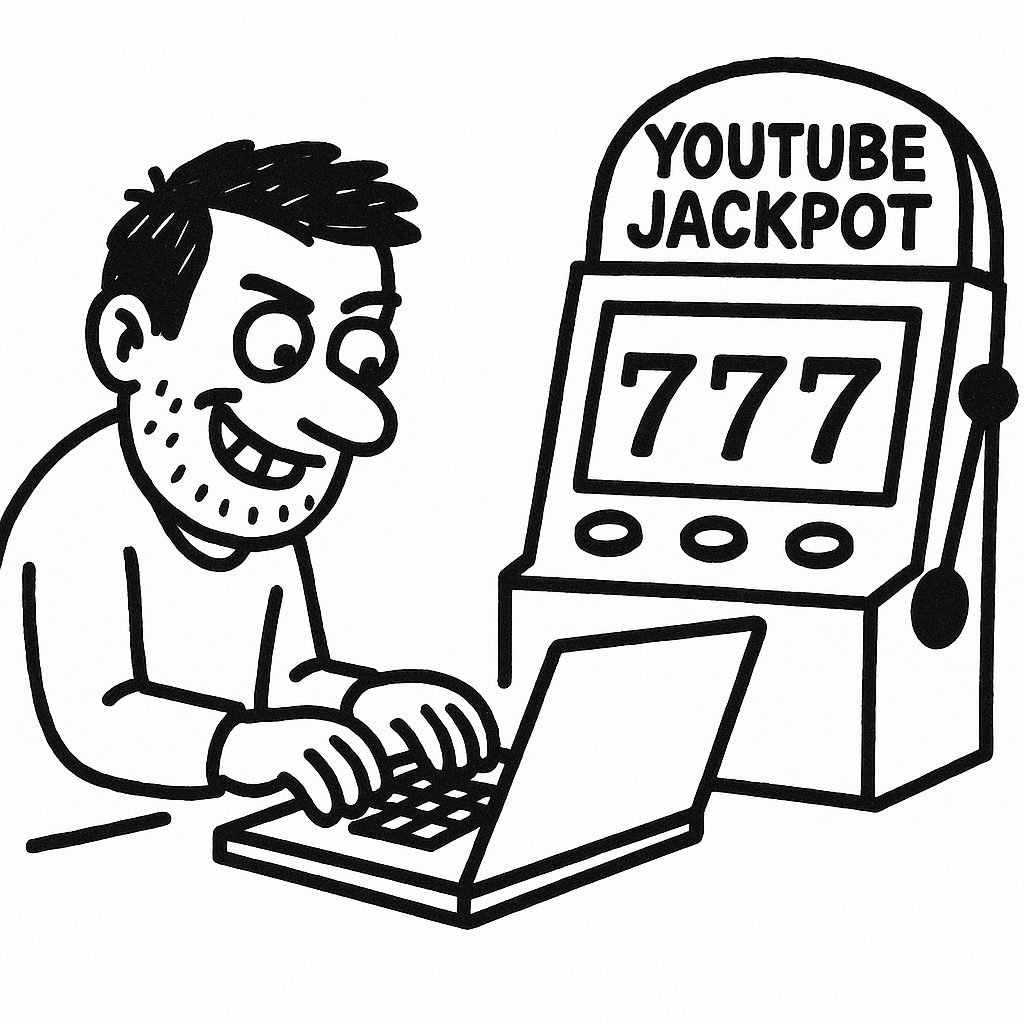
Despite doing some stuff for seemingly random and arbitrary reasons, the algorithm is capable. It’s the same algorithm that draws millions of people into an endless rabbit hole of recommended videos. It’s the same algorithm that can act as a ‘big brother‘ that will censor certain words and sentiments. Sure, it’s often used in the wrong way, but you can’t say that it’s stupid.
But I didn’t know that. I re-released videos. I gamed the keywords. I released the same videos on different channels. Sure, it used to work in the olden days of the internet. Hell, it still even works today, albeit in the short term. But trust me, the algorithm will pick it up and penalize your channel without even noticing you. The good rule is: that if you do something that will confuse, disappoint, or upset your core audience, the algorithm will most likely see it and punish your channel.
Play it safe, don’t be greedy, and be honest with your audience.
12. Treat the YouTube algorithm as a business

Recommendations don’t come without strings attached. When YouTube recommends your videos, it expects you to make users stay as long as they can. If you fail to do so, they will penalize you and recommend someone else instead. Just like in business, you shouldn’t waste someone’s time when you don’t bring anything worthwhile in return. In this simile, you shouldn’t waste YouTube’s recommendations by releasing videos that your core audience isn’t interested in. You would be better off uploading and playing it safe by releasing stuff you know most likely to work.
Note: this only applies when your audience is recommendation-based, and you’re currently having steady traffic of recommendations. Search-based audience or nonexistent recommendations traffic does not follow the same rule. In this case, experimentation is good, since you have nothing to lose!
YouTube algorithm isn’t a charity; once you get something, you have to give something in return. Once you earn its trust, better not break it.
Thank you for reading my article!
Feel free to comment down below and share your feedback, point of view, or your experience. Discussion is highly encouraged.
This content originally appeared on HackerNoon and was authored by Faz Forward